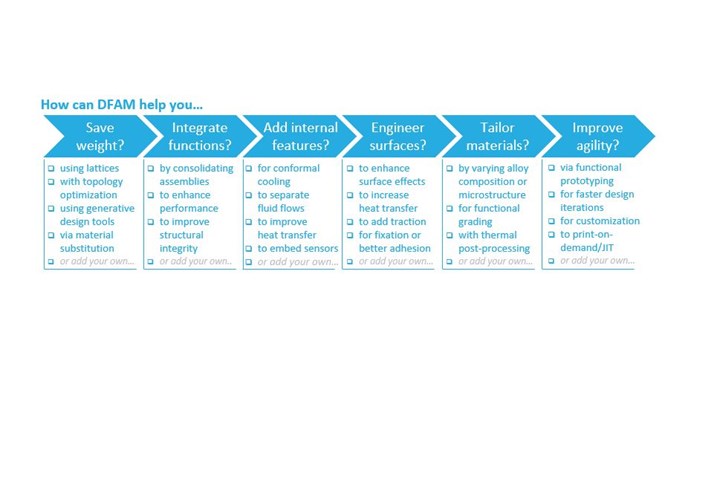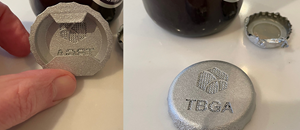Finding Value with Design for Additive Manufacturing
Six questions can help you find value as you apply DFAM.
Share
Read Next
Last month I discussed how Design for Additive Manufacturing (DFAM) is the value multiplier when it comes to additive manufacturing (AM). For example, if we use DFAM to lightweight a component, then that reduces material costs, decreases build time, lowers machine costs, and saves on pre-/post-processing, all of which lead to a much less expensive metal AM part when using laser powder bed fusion (PBF). In fact, these savings are at least 3x-4x in magnitude compared to an equivalent reduction in the cost of material feedstock or an increase in build speed from doubling the number of lasers or increasing laser power. Even better, you control DFAM; you are not at the mercy of an OEM or powder supplier to lower your costs.
Saving weight is only one aspect of DFAM, which begs the obvious question: how do I find the value when applying DFAM? If you recall from my article on AM standards, there is a standard for DFAM, namely, ISO/ASTM 52910:2017(E): Standard Guidelines for Design for Additive Manufacturing. ISO/ASTM also has more detailed design standards for laser PBF with metals and polymers (see: ISO/ASTM 52911-1:2019(E) and ISO/ASTM 52911-1:2019(E), respectively), and ASTM has released a design standard for metal AM with directed energy deposition (see: ASTM F3413-2019). All of these standards provide useful information and helpful guidelines when designing for AM, but there is little guidance on how to operationalize the overall strategy for DFAM or the “identification of AM potentials” that are offered in the first two figures in ISO/ASTM 52910:2017(E).

Use these six questions and combine the answers in the figure to help find value in DFAM.
Photo Credit: Timothy W. Simpson
While the overall strategy for DFAM will vary by industry and company, I am starting to see a national ordering emerge to the implementation of DFAM in the workshops and training I have been doing with The Barnes Global Advisors. To help you with your DFAM implementation, ask yourself the following six questions and pick one (or more) of the answers provided to help you find value with AM (see figure above).
1. How can DFAM help save weight?
This first question tends to be the first thing that people try when implementing DFAM. It is easy to understand why—saving weight reduces fuel consumption on airplanes, improves acceleration of racecars, and makes lighter implants, all of which add value to the AM part. There are also multiple ways to realize this value with DFAM, including topology optimization, generative design tools, lattice/cellular structures, and material substitutions, to name a few.
2. How can DFAM help integrate functions?
Once you have identified ways to save weight in a single part, it is natural to look at adjacent parts to see if there are ways to combine functions (e.g., structural, thermal, electrical) or consolidate parts. This offers benefits beyond the part itself, including enhanced performance, further weight savings, less assembly, less inventory, less sourcing, etc. when multi-piece assemblies are consolidated (or unitized) with AM.
3. How can DFAM help create novel internal features?
Once you have lightweighted a part or consolidated an assembly, the next step is to look internally — are there internal features that could be added to increase the value of AM? Such features could be used to improve thermal management, add conformal cooling, channel or separate fluid flows in novel ways, or create passageways to embed circuitry or sensors for feedback or prognostic health monitoring, for instance. These DFAM implementations will help add value to the AM part by enhancing performance while further reducing costs.
4. How can DFAM help engineer innovative surfaces?
The next question directs your attention to surfaces to see if there are ways to engineer surfaces to improve functionality or performance. Most view surface roughness as a bad thing, but there are ways to use it to improve fixation (on an implant, for example), add traction to surfaces (for better bonding), or enhance surface effects to promote better heat transfer, for instance. This can be done during the AM build or imparted afterward with secondary post-processing techniques such as abrasive flow machining to smooth internal channels and passageways. Granted, there may be some side effects and tradeoffs with such surfaces (e.g., increased pressure drop in a heat exchanger), but savvy engineers will find ways to work around these with AM.
5. How can DFAM help tailor materials?
As the design geometry is altered in response to the previous questions, opportunities to improve or even tailor the material may be identified to add further value when applying DFAM. While this is not possible with all AM processes, the ability to vary the material composition during deposition to tailor the coefficient of thermal expansion, increase hardness or wear resistance on the outside of a part, or improve the fatigue life by varying the internal microstructure, for example, are all now possible. Capitalizing on the “material freedoms” of AM can be done during the build or by thermal post-processing after the build is complete.
6. How can DFAM improve agility?
While the design and material freedoms associated with AM will benefit the actual part itself, DFAM can also be used to improve the development process by making it more agile, flexible, and responsive. This arises from the combination of speed and digitalization available with AM, which have been parlayed into personalized and mass customized offerings in several industries (e.g., hearing aids, prostheses, bicycles). Meanwhile, functional and parallel (vs. serial) prototyping can expedite design iterations and improve concept development and exploration. AM is also enabling companies to build “digital warehouses” and “digital inventories” for printing-on-demand and entirely new business models enabled by digital manufacturing technologies like AM.
Navigating all of the possibilities can be challenging for companies new to DFAM; however, the six questions, when asked in this order, provide a good starting point to help you focus your discussion and identify a ways to realize the value with DFAM. If you are still struggling, then simply select one “response” from each question and ask yourself if/how you could apply that combination of DFAM to your part (or product)? While all combinations may not apply, it will certainly help you find value with DFAM.
Related Content
A Framework for Qualifying Additively Manufactured Parts
A framework developed by The Barnes Global Advisors illustrates considerations and steps for qualifying additively manufactured parts, using an example familiar to those in AM: the 3D printed bottle opener.
Read MoreWhat is Powder Bed Fusion 3D Printing?
Whether in metal or polymer, with a laser or an electron beam, powder bed fusion (PBF) is one of the most widely used 3D printing techniques.
Read More10 Important Developments in Additive Manufacturing Seen at Formnext 2022 (Includes Video)
The leading trade show dedicated to the advance of industrial 3D printing returned to the scale and energy not seen since before the pandemic. More ceramics, fewer supports structures and finding opportunities in wavelengths — these are just some of the AM advances notable at the show this year.
Read MoreAM 101: What Is Binder Jetting? (Includes Video)
Binder jetting requires no support structures, is accurate and repeatable, and is said to eliminate dimensional distortion problems common in some high-heat 3D technologies. Here is a look at how binder jetting works and its benefits for additive manufacturing.
Read MoreRead Next
3D Printing Brings Sustainability, Accessibility to Glass Manufacturing
Australian startup Maple Glass Printing has developed a process for extruding glass into artwork, lab implements and architectural elements. Along the way, the company has also found more efficient ways of recycling this material.
Read MoreAt General Atomics, Do Unmanned Aerial Systems Reveal the Future of Aircraft Manufacturing?
The maker of the Predator and SkyGuardian remote aircraft can implement additive manufacturing more rapidly and widely than the makers of other types of planes. The role of 3D printing in current and future UAS components hints at how far AM can go to save cost and time in aircraft production and design.
Read More4 Ways the Education and Training Challenge Is Different for Additive Manufacturing
The advance of additive manufacturing means we need more professionals educated in AM technology.
Read More





















